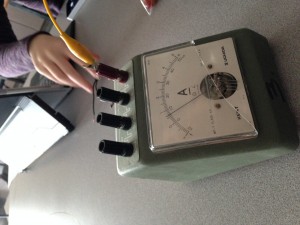Current Electricity
Hypothesis
The strawberries will generate the most amount of voltage because they are acidic.
More acidic fruit= more hydrogen ions = more charge carriers.
Observations
Our dependent variable was the voltage, how much voltage the fruit will produce.
Our independent variable was the fruits, where we used apples, kiwis, grapes, strawberries.
Our controlled variables were same size, and weight, same type of nails and wires, the environment
After we checked the final results, we saw that the kiwi produced the most amount of voltage, and I was really impressed by this. We then saw that the strawberries gave a negative number, but it was because every time you change the wires, the signs do. We then forgot that we didn’t had the same size for each fruit, what might have done some changes to the results. Because the fruits didn’t had the necessary energy to make the bulb light up, we weren’t able to make the bulb light up, to find out if electrons were flowing we just checked the voltage meter. Also, to make this work we had to do a series circuit. We think that to improve the experiment we should use the same size and weight for the fruits. We could use this for our everyday life, how? Well, you can make an emergency battery, just make sure you have a lot of fruits to do it.
Conclusion
The kiwi created the most amount of voltage. We didn’t tried the lemon, but I wish we could because it seemed to be the best in the class.
This is how it works
I did some research about the topic, and the fruits batteries work because the acid in the fruit acts as the electrolyte but the energy itself comes from the difference in potential between the two electrodes. The Zinc is oxidized inside the fruit|vegetable, exchanging some of its electrons in order to reach a lower state, releasing electrons which pair up with the hydrogens ions to form hydrogen gas. The electrons will then flow through the wires towards the copper plate, giving it a small negative charge, which in turn, attracts the positively charged hydrogen ions. The most noticeable effect is that the hydrogen bubbles will be produced around the copper rather than around the zinc, which tends to be saturated with positively charged zinc ions. The lemon merely provides an environment where this can happen, but they are not used up in this process.
I got some information from this sites
https://van.physics.illinois.edu/qa/listing.php?id=43600&t=current-from-battery
https://www.reference.com/science/fruit-conduct-electricity-debd1102edcaa360


